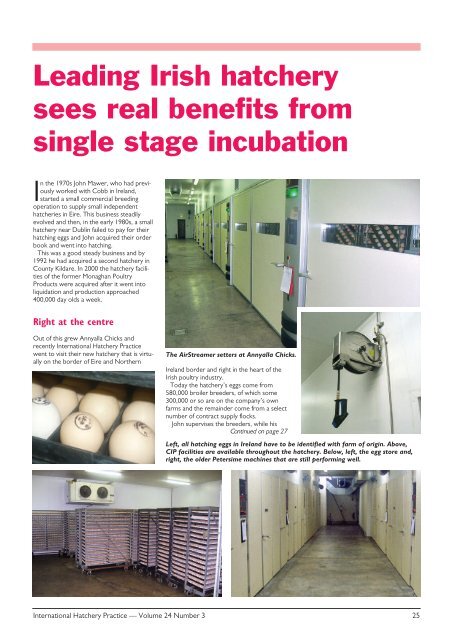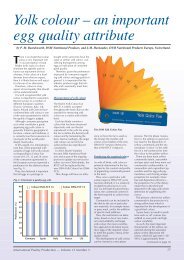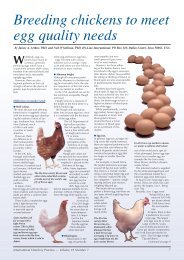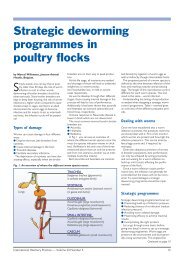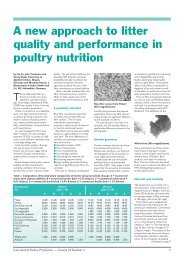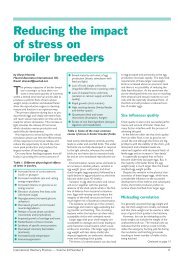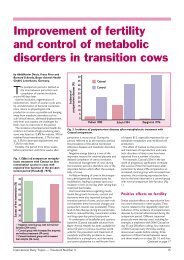Leading Irish hatchery sees real benefits from single stage incubation
Leading Irish hatchery sees real benefits from single stage incubation
Leading Irish hatchery sees real benefits from single stage incubation
You also want an ePaper? Increase the reach of your titles
YUMPU automatically turns print PDFs into web optimized ePapers that Google loves.
<strong>Leading</strong> <strong>Irish</strong> <strong>hatchery</strong><br />
<strong>sees</strong> <strong>real</strong> <strong>benefits</strong> <strong>from</strong><br />
<strong>single</strong> <strong>stage</strong> <strong>incubation</strong><br />
In the 1970s John Mawer, who had previously<br />
worked with Cobb in Ireland,<br />
started a small commercial breeding<br />
operation to supply small independent<br />
hatcheries in Eire. This business steadily<br />
evolved and then, in the early 1980s, a small<br />
<strong>hatchery</strong> near Dublin failed to pay for their<br />
hatching eggs and John acquired their order<br />
book and went into hatching.<br />
This was a good steady business and by<br />
1992 he had acquired a second <strong>hatchery</strong> in<br />
County Kildare. In 2000 the <strong>hatchery</strong> facilities<br />
of the former Monaghan Poultry<br />
Products were acquired after it went into<br />
liquidation and production approached<br />
400,000 day olds a week.<br />
Right at the centre<br />
Out of this grew Annyalla Chicks and<br />
recently International Hatchery Practice<br />
went to visit their new <strong>hatchery</strong> that is virtually<br />
on the border of Eire and Northern<br />
The AirStreamer setters at Annyalla Chicks.<br />
Ireland border and right in the heart of the<br />
<strong>Irish</strong> poultry industry.<br />
Today the <strong>hatchery</strong>’s eggs come <strong>from</strong><br />
580,000 broiler breeders, of which some<br />
300,000 or so are on the company’s own<br />
farms and the remainder come <strong>from</strong> a select<br />
number of contract supply flocks.<br />
John supervises the breeders, while his<br />
Continued on page 27<br />
Left, all hatching eggs in Ireland have to be identified with farm of origin. Above,<br />
CIP facilities are available throughout the <strong>hatchery</strong>. Below, left, the egg store and,<br />
right, the older Petersime machines that are still performing well.<br />
International Hatchery Practice — Volume 24 Number 3 25
Continued <strong>from</strong> page 25<br />
son, also called John, is responsible for the<br />
<strong>hatchery</strong> operation and day old sales.<br />
Today, some 1.4 million day olds are<br />
hatched a week with some 300-400,000 per<br />
week going into the UK market where the<br />
company also contract hatches some of its<br />
eggs.<br />
The hatching eggs come <strong>from</strong> farms close<br />
to the <strong>hatchery</strong> as well as a cluster of farms<br />
some 4-5 hours away in Limerick.<br />
Four collections a week are taken <strong>from</strong> the<br />
bigger farms, whereas eggs are shipped <strong>from</strong><br />
the smaller farms when enough eggs have<br />
been collected to fill an egg vehicle. All eggs<br />
are fumigated on receipt at the <strong>hatchery</strong>.<br />
Currently, most of the breeders are Ross<br />
308s with some Cobb and Hubbard JA57s.<br />
These last breeders produce Hubbard<br />
JA575 broiler day olds.<br />
Routine vaccinations<br />
The broiler breeder parent flocks are routinely<br />
vaccinated against Newcastle disease,<br />
infectious bronchitis and Gumboro disease<br />
as well as Marek’s disease. The flocks are<br />
free of Salmonella enteritidis and typhimurium.<br />
Five settings are placed per week. Two of<br />
these are large settings (345,000 eggs) and<br />
three are smaller (230,000 eggs).<br />
Currently, overall mean hatchability is 80%<br />
with an overall hatch of fertile figure<br />
approaching 90%. To maintain a steady egg<br />
flow breeders are placed in blocks of 40,000<br />
either as part of one of the larger farms or<br />
by combining two or more smaller contract<br />
flocks.<br />
The original <strong>hatchery</strong> had Petersime 576<br />
setters which John found were good,<br />
straightforward machines to operate.<br />
In the extension to the <strong>hatchery</strong> Annyalla<br />
Chicks chose to go with Petersime’s<br />
AirStreamer setters. This was because the<br />
AirStreamer gave them a further 1% of<br />
hatchability on top of that being achieved by<br />
the 576s.<br />
In addition, the <strong>single</strong> <strong>stage</strong> AirStreamer<br />
Above, the AirStreamer hatchers and,<br />
right, chick grading.<br />
gave <strong>benefits</strong> in terms of hygiene as well as<br />
more consistency with fewer unexplained<br />
dips in hatchability over time.<br />
Excellent service<br />
The other thing that was in Petersime’s<br />
favour was the support and service they had<br />
given to the company over the years. If a<br />
spare part was not on the shelves of the<br />
<strong>Irish</strong> agent it could be flown into Dublin<br />
<strong>from</strong> Petersime’s Belgian operation and be<br />
at the <strong>hatchery</strong> within 24 hours!<br />
Eggs come into the <strong>hatchery</strong> on setter flats<br />
and are then transferred to setter trolleys<br />
before being held at 17-18°C and a relative<br />
humidity of 65% until they are needed for<br />
setting.<br />
Fumigation is in a special, purpose built<br />
facility and uses formaldehyde prills.<br />
When the <strong>hatchery</strong> was acquired much of<br />
the egg and chick processing equipment was<br />
Breuil, but over the years the <strong>hatchery</strong> has<br />
moved over to equipment <strong>from</strong> John<br />
Haycock. In the chick processing area blue<br />
light is used. ■<br />
Left, chick removal <strong>from</strong> the hatcher trays and, right, wetting of debris in the hatcher trays before tipping and tray washing.<br />
International Hatchery Practice — Volume 24 Number 3 27


